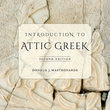 Accentuation Tutorial
Accentuation Tutorial

|
TOPICS Accent and Accent-Marking in Ancient Greek The Last 3 Syllables and the Accents Enclitics Persistent Accentuation |
(b) A word accented with an acute on P is itself unchanged in accent before a monosyllabic or disyllabic enclitic. A following monosyllabic enclitic has no accent as usual. But a disyllabic enclitic following such a word receives an accent on its second syllable. The occurs because after the first mora following contonation the word is still not complete. The accent on the second syllable of the disyllabic enclitic is usually an acute (in isolation or before punctuation) or a grave (replacing the acute in a connected context). Rarely, as with the genitive plural τινῶν, the added accent is a circumflex, although this may be a convention of writing rather than a reality of speech. (In the following examples, the word unit of head word plus enclitic is in brown and the original contonation and the additional accent, if any, are underlined.) λόγος τις – “a certain account”; acute on P unchanged, monosyllabic enclitic without accent λόγῳ τινί – “by a certain account”; acute on P unchanged, disyllabic enclitic with acute on second syllable in isolation λόγῳ τινὶ καλῷ – “by a certain fine account”; acute on P unchanged, disyllabic enclitic with grave on second syllable in connected utterance λόγων τινῶν – “of certain accounts”; acute on P unchanged, disyllabic enclitic with circumflex on second syllable |
||||